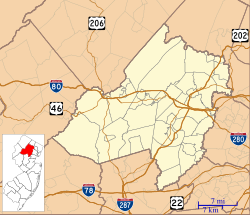
Fairmount is an unincorporated community located along County Route 517 in Tewksbury Township of Hunterdon County, New Jersey. The community was first known as Parkersville, named after proprietor James Parker (1725–1797). The southern section of the community is known as Lower Fairmount.

The Fairmount Historic District is a 409-acre (166 ha) historic district located along County Route 517 in the Fairmount section of Tewksbury Township, near Califon, in Hunterdon County, New Jersey. It was added to the National Register of Historic Places on December 20, 1996 for its significance in architecture, exploration/settlement, and industry. The district includes 72 contributing buildings that were deemed to be contributing to the historic character of the area, plus five contributing structures, nine contributing sites, and one contributing object. One contributing building is located in Washington Township, Morris County.

Mays Landing Presbyterian Church is a historic church built in 1841 and located at Main Street and Cape May Avenue in the Mays Landing section of Hamilton Township in Atlantic County, New Jersey, United States. It was documented by the Historic American Buildings Survey (HABS) in 1938 and was added to the National Register of Historic Places on April 20, 1982, for its significance in architecture and religion. The church was added as a contributing property to the Mays Landing Historic District in 1990.

St. James' A.M.E. Church is a historic church located at High and Court Streets in Newark, New Jersey. Built in 1850 by architect John Welch and dedicated in 1854, it was originally called the High Street Presbyterian Church until 1926, when it was briefly disbanded. It was re-established as Bethel AME Church before being renamed Saint James' AME Church.
Isaac Pursell was a Philadelphia, Pennsylvania-based architect.
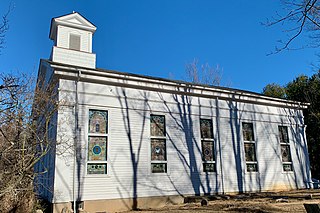
Cokesbury, historically known as Cokesburg, is an unincorporated community located on the border of Clinton and Tewksbury townships in Hunterdon County, New Jersey. It was named after two Methodist bishops, Coke and Asbury. The Cokesbury Historic District was listed on the state and national registers of historic places in 1997.

North Danville Historic District is a national historic district located at Danville, Virginia. The district includes 426 contributing buildings in a primarily residential area of Danville. The district also includes three blocks of primarily two-story, brick commercial buildings. Buildings within the district were constructed from about 1880 to about 1955 and reflect a wide variety of architectural styles including vernacular Victorian, Italianate, Queen Ann, Colonial Revival, Tudor Revival, and Bungalow designs. Many of these buildings were built by Dan River Cotton Mills founder T.B. Fitzgerald. Notable buildings include the Calvary United Methodist Church (1886), Shelton Memorial Presbyterian Church (1889), Bellevue Public School (1898), Washington Street Methodist Episcopal Church (1910), Keen Street Baptist Church (1927), and Woodrow Wilson High School (1926).
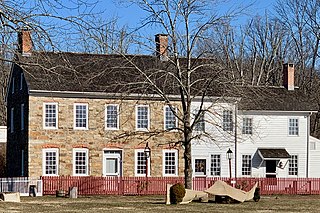
Van Syckel is an unincorporated community located within Union Township in Hunterdon County, New Jersey. The Van Syckel Corner District was listed on the National Register of Historic Places in 1979.

The Park-to-Park Residential Historic District in Fort Madison, Iowa, United States, was listed on the National Register of Historic Places in 2014. The historic district is located to the north of the Downtown Commercial Historic District, generally between Central Park on the west and Old Settler's Park on the east. Both parks are contributing sites. For the most part the district is made up of single family homes built in the late 19th and early 20th centuries. Some of these homes were built as rental properties, while others became so in later years. The Albright House and the Chief Justice Joseph M. Beck House are contributing properties, and they are also individually listed on the National Register. There are also duplexes and a few small scale apartment buildings in the district.

The Whitehouse–Mechanicsville Historic District is a historic district located along old New Jersey Route 28, Mill, Lamington and School Roads in Whitehouse and Mechanicsville, unincorporated communities in Readington Township, Hunterdon County, New Jersey. It was added to the National Register of Historic Places on March 17, 2015 for its significance in architecture and community development. The district includes 140 contributing buildings.

The Asbury Historic District is a 288 acres (117 ha) historic district encompassing the community of Asbury in Franklin Township of Warren County, New Jersey. It is bounded by County Route 632, County Route 643, Maple Avenue, Kitchen Road, and School Street and extends along the Musconetcong River into Bethlehem Township of Hunterdon County. It was listed on the National Register of Historic Places on March 19, 1993 for its significance in architecture, industry, religion, community development, politics/government, and commerce. The district includes 141 contributing buildings, a contributing structure, two contributing sites, and four contributing objects.
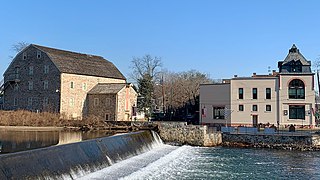
The Clinton Historic District is a 175-acre (71 ha) historic district encompassing much of the town of Clinton in Hunterdon County, New Jersey. It was added to the National Register of Historic Places on September 28, 1995, for its significance in architecture, commerce, engineering, industry and exploration/settlement. The district includes 270 contributing buildings, one contributing structure, and three contributing sites. Five were previously listed on the NRHP individually: Dunham's Mill, M. C. Mulligan & Sons Quarry, Music Hall, Old Grandin Library, and Red Mill.

The Methodist Episcopal Church, also known as the Methodist Episcopal Church of Hibernia, is a historic church built in 1869 and located at 419 Green Pond Road in the Hibernia section of Rockaway Township, Morris County, New Jersey. It was added to the National Register of Historic Places on July 14, 2011, for its significance in architecture and industry. Since 1970, the building has been used as a branch of the Rockaway Township Free Public Library.

The Boonton Historic District is a 9-acre (3.6 ha) historic district along Main, Church, Birch, Cornelia, and Cedar Streets in the town of Boonton in Morris County, New Jersey. It was added to the National Register of Historic Places on September 29, 1980, for its significance in architecture. The district has 22 contributing buildings, including the Boonton Public Library, which was previously listed individually on the NRHP.
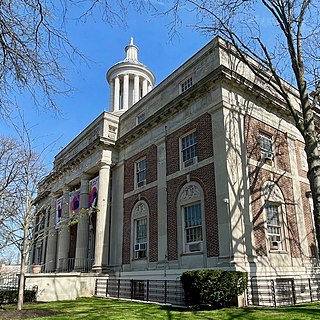
The Plainfield Civic District is a 2-acre (0.81 ha) historic district located in the city of Plainfield in Union County, New Jersey. It was added to the National Register of Historic Places on June 17, 1993 for its significance in architecture, politics/government, and community planning. The district includes three contributing buildings and one contributing object.

The Morristown District, also known as the Morristown Historic District, is a historic district in the town of Morristown in Morris County, New Jersey. It was added to the National Register of Historic Places on October 30, 1973, for its significance in architecture, communications, education, military, politics, religion, social history, and transportation.

The Dr. Lewis Condict House is a historic house located at 51 South Street in Morristown of Morris County, New Jersey. Built in 1797, it was added to the National Register of Historic Places on April 3, 1973, for its significance in architecture and health/medicine. In 1937, the Woman's Club of Morristown purchased the house for its headquarters. The house was added as a contributing property to the Morristown District on October 30, 1973.

The First Presbyterian Church is located at 57 E. Park Place in the town of Morristown in Morris County, New Jersey. The congregation started worship here in 1733. It received a royal charter from George II of Great Britain in 1756. The current church building was erected in 1894. The stone building features Romanesque Revival architecture and works by Louis Comfort Tiffany. The church was added to the National Register of Historic Places, listed as a contributing property of the Morristown District, on October 30, 1973.
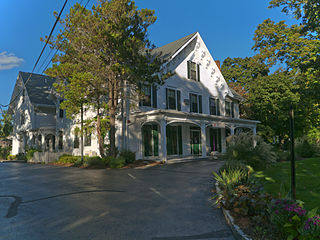
The Cutler Homestead is a historic house located at 21 Cutler Street in the town of Morristown in Morris County, New Jersey. Originally built in 1799 by Joseph Cutler for Silas Condict, it was added to the National Register of Historic Places on March 10, 1975, for its significance in architecture, law, and politics/government.

St. Mary's Church is a historic Roman Catholic parish church located at 371 South Main Street in the borough of Wharton in Morris County, New Jersey, United States. The parish was founded in 1845 and serves the communities of Wharton, Dover, and Mine Hill Township. It is part of the Diocese of Paterson. The Gothic Revival stone church was designed by architect Jeremiah O'Rourke and built from 1872 to 1873. Listed as Saint Mary's Roman Catholic Church, it was added to the New Jersey Register of Historic Places in 1997. The church buildings and grounds were added to the National Register of Historic Places in 2023.

